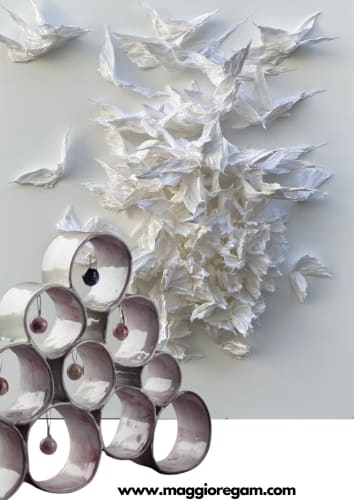After the retrospective dedicated to Fausto Melotti in 1999, Galleria d'Arte Maggiore g.a.m. is glad to show another selection of his refined works. Melotti's entire production, from the early drawings of the 1920s to the sculptures of the 1980s, makes it clear that, as Germano Celant writes: "his abstractism must be assumed in a spiritualistic and metaphysical perspective, with references to the symbolism of the sacred and the magical. And although it may appear irreverent from a figurative point of view, it always admits at its origin the spirit or the word, the sound or the breath with which the universe was built". Sculptur, poet, musician and with a degree in Electronic Engineering, Melotti took his first steps into plastic arts using ceramics, with a broad but refined production that led him to collaborate with Gio Ponti on his architectural projects. Known for his joyful and lively use of brass, Melotti's production is characterized by light sculptures. They are light not only because of their own constitution - which aims to ab-strahere (to bring out the form) and to free them from a concrete existence - but also because of the amusement they require in engaging the viewer, called to construct fantastic narratives and surreal universes through the playful irregularities, oscillations and symmetries of the works themselves.
Claudine Drai handles silk and japanese paper to make the invisible visibile, the immaterial material, giving shape to the genesis of the art creation. The light and delicate forms, barely hinted at, emerge from the canvas to play with light and shadow, making an eternal fragile world animated by ephemeral figures, like angels, birds, or flowers, which are bodies without a body. The delicacy of her creations is underlined by the prevailing white, that translates into transparency, illusions and light tricks, in an atmosphere where time stands still. Through her art, the French artist engages not only sight, but, ideally, also touch and smell. Claudine Drai offers us a reality enriched with consciousness and sensations. This sensory awakening opens the field to an aesthetic adventure where the slightest counterpoint, the slightest twist, the slightest modulation construct the meaning of the work. In 2021 German filmmaker Wim Wenders was so fascinated by Claudine Drai's art that he decided to create a 3D video artwork called présence, exploring the suggestions coming from it as well as the act of creating the work of art. It premiered at Palazzo Grassi in Venice during the opening week of the Venice Biennale 2022 and it is now part of the Centre Pompidou collection. After being included in the Guérlain collection, a large installation composed of multiple works by Claudine Drai will be hosted by the Center Pompidou from October until February 25, 2025, when the work will enter the permanent collection of the Parisian museum.
«Matta is the one who most pursues his own fate, which maybe is the only way to discover the highest secret of all: the control of fire»: with these words André Breton describes Roberto Sebastian Matta, in 1944. Architect, painter and - what's more - a virtuoso in the use of bronze and metals, it is within his own artistic production that the words of the Surrealist leader are proved to be true: his figures are images of magmatic deepness, hailing back to geological ancient epochs and earthly mythological religions. In fact, in his sculptures he evokes all the traditions already existing: the totemic idol of ancient civilizations with serpents' eyes derived from Inca or Aztec culture meld with the fecund, natural deities of the Etruscans, in an unending quest for the roots of the history of mankind, which is blended with the artist's studies of Oceanic and primitive art such as the African one, greatly in vogue among the leading artists of the past century. As a master of fire, Matta forged bronze into sculptures that resemble ancient gods and goddesses, emerging from a prehistorical and ancient past, from Greece, Mediterranean or South American cultures. The eternal light, the fire, is what these works are conceived with. Furthermore, in Matta's idea, man is made of the same material as stars: the light. That is the same light that he represents in art with his psycological morphologies, whether made of color or of bronze.
At last, the mastery of Giorgio Morandi is fully expressed in a selection of his etchings, where lightness becomes quietness. For more than twenty-five years, he served as Etching Professor at Bologna Fine Arts Academy. The works on paper on display, silent but powerful, disclose one of the fundamentals of his poetics, that is suggesting an entire lyrical universe through a studied economy of subjects as well as of lines: common and simple objects, such as vases, bottles, flowers, shells and landscapes he would look at in his studio or would glimpse from the view of a window, whether in Via Fondazza or in Grizzana. Following Cézanne who declared that «shadow is a colour as light is, but less brilliant; light and shadow are only the relation of two tones» Giorgio Morandi spent his time engraving the plate, studying how to give a visual expression to light. His etchings show the chromatic play limited to the contrast between the engraved sign and paper, between the hatching and the spaced deliberately left white in the composition which gives you the feeling of making you blind by looking at it. To Morandi etching is pure light research, expressed at its full power using a denser or rarer trait until the trait itself becomes absent. Etching allowed Morandi to express light's blinding power with an outcome that could not be reached in painting, giving life to a juxtaposition of light and shadow which would generate the delicate shapes of the objects themselves. It is in these works that the evocative ability of Morandi's intimate and meditated world emerges in its essentiality.




